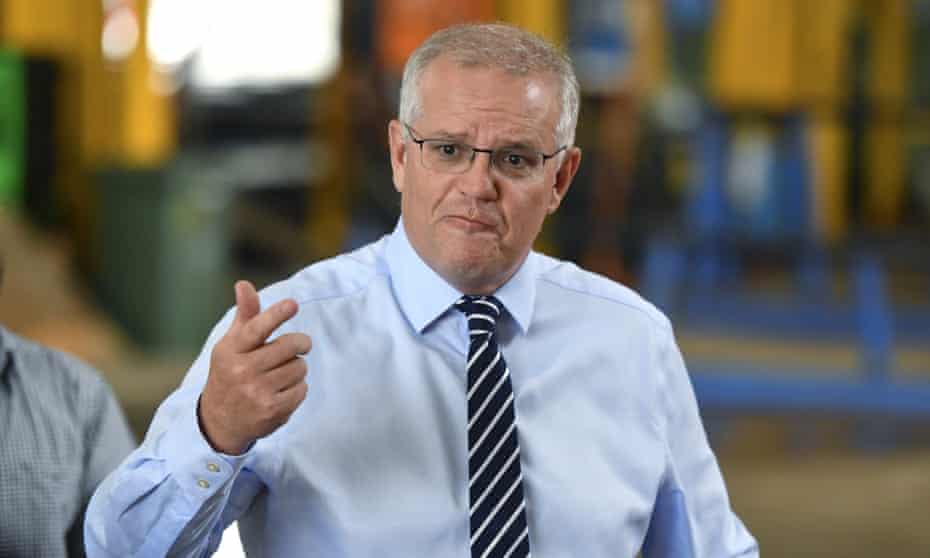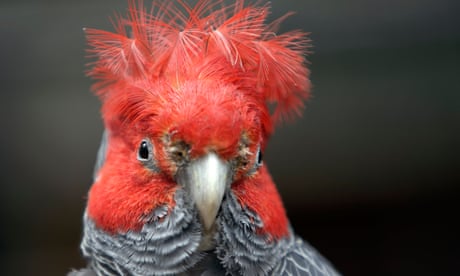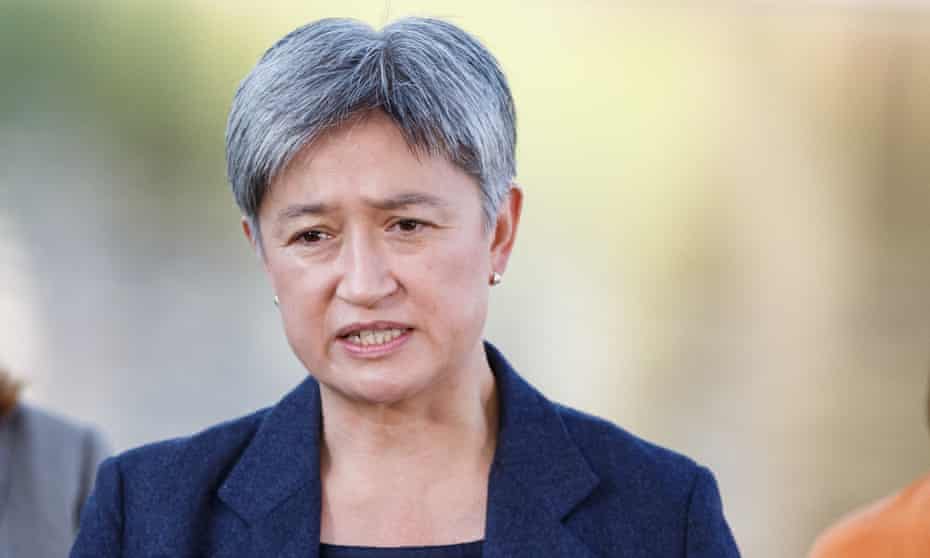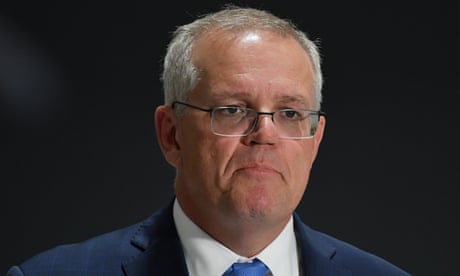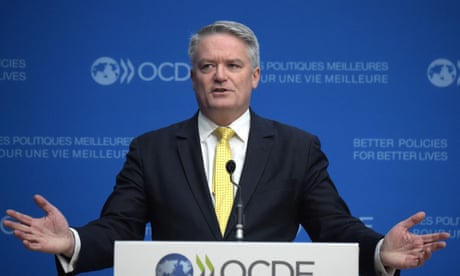Extract from The Guardian
- Temperature Check is a weekly column examining claims about climate change made by governments, politicians, business and the media – follow the series here
- Guardian Australia’s full federal election coverage

‘Scott Morrison accusing Labor of planning to introduce a “carbon tax” is election campaign shamelessness on steroids.’
Scott Morrison and other government MPs are accusing Labor of planning to introduce a “sneaky carbon tax” by – wait for it – using an existing Coalition policy as it was intended.
Sounds ridiculous, right? Election campaign shamelessness on steroids. But there is a lot going on here and it is worth stepping through it.
What is the policy?
The awkwardly named safeguard mechanism was created by Greg Hunt, the former environment minister and introduced under then prime minister Tony Abbott, a well-known climate sceptic. It was legislated in 2014 as part of what was then known as the Coalition’s “direct action” policy.
The idea was that emissions limits would be set for the country’s biggest industrial sites, those that emit more than 100,000 tonnes of carbon dioxide a year. The limits – known as baselines – would stop “rogue” polluters from significantly increasing emissions and effectively wiping out any cuts the government paid for from farmers and others through its emissions reduction fund.
The baselines were meant to “safeguard” those cuts. If a company went over its baseline it would have to buy carbon credits to offset the extra pollution pumped into the atmosphere.
In practice, that hasn’t happened. Industrial emissions continue to increase – by 7% since the safeguard was introduced – as the government has mostly just allowed companies to increase baselines, or change the timeframe over which baselines are measured, without penalty.
Industry representatives, climate activists and analysts believe it has made the scheme a waste of time and have long called for an overhaul.
How has the government responded?
The government has refused to acknowledge that industrial emissions are an issue that need to be addressed now. Official government projections show they are not expected to be cut before 2030 under the Coalition’s policies.
The government’s ambition for the safeguard mechanism has reduced since its early days. Shortly before the landmark Paris climate conference in 2015, Hunt included it as part of Australia’s pledge to the summit and said it would be developed to cut emissions from industrial polluters by 200m tonnes between 2020 and 2030.
But the ministers who followed him – Josh Frydenberg, Melissa Price and Angus Taylor – have not repeated that claim, and the Coalition now has no plans to require industrial polluters to cut emissions.
Instead, it assumes cleaner technology will eventually lead to businesses taking voluntary steps to deliver most emissions cuts. It has not explained the basis for this assumption in any detail.
What is Labor proposing?
The Business Council of Australia, which in the past had campaigned for the abolition of the country’s carbon pricing scheme and described a science-based emissions target as “economy wrecking”, last year had something of a reversal on climate policy.
In October, the business council called for Australia’s climate target for 2030 to be increased to a 46% to 50% cut – more than Labor’s 43%, and nearly twice as much as the Coalition’s 26-28% – and released a policy blueprint. It said the safeguard should be “enhanced and expanded” to “deliver a strong carbon investment signal to invest in new low, zero and negative emissions technology”. Others, including the Australian Industry Group, support this position.
Labor’s safeguard policy, released in December, basically adopted the business council’s recommendations. It said if it was in government the baselines for the 215 major industrial sites covered by the safeguard would be cut “predictably and gradually” in a way that supported “international competitiveness and economic growth”.
Big emitting export industries – coalmines, for example – would get “tailored treatment” to ensure they weren’t disadvantaged against other countries where there was not an equivalent scheme in place. Opposition MPs appeared to stumble trying to explain this, with some suggesting coalmines in the Hunter valley would be exempt, while the opposition climate change and energy spokesperson, Chris Bowen, said they would be included but their circumstances meant they wouldn’t face a hit.
It was mostly a semantic difference but it underlined that there are many details still to come if Labor wins. Modelling for the ALP by RepuTex suggests it could use the safeguard to cut emissions by 213m tonnes by 2030 – roughly similar to what Hunt proposed back in 2015 – while creating 1,600 mostly regional jobs. The policy said officials would work out new baselines in consultation with industry on a case-by-case basis.
What would it mean for fossil fuel industries?
Power generation is not included in the safeguard, but fossil fuel exports – coal and gas – are. Labor says that demand for thermal coal and liquified natural gas exports will fall as the world cuts emissions, but it would not penalise those industries against overseas competitors while people want to buy their product.
The Coalition’s net zero plan also acknowledges a long-term decline for coal and gas but has a different emphasis. It says both industries “will continue through to 2050 and beyond, supporting jobs and regional communities”. Given carbon capture and storage’s lack of economic viability, that appears to be banking on the world failing to address the crisis, a situation that would lead to worsening extreme weather and climate disasters.
Among the parties, only the Greens say Australia has a responsibility to significantly cut emissions from fossil fuel export industries in line with climate science. They want a levy on coal exports that would be used to fund climate disaster recovery and development of new clean exports, and for the industry to end by 2030.
Morrison this week said the government had “put incentives in place” while “what Labor is doing is binding them on this and issuing penalties on those companies”. What did that mean? Is it fair?
It’s not exactly clear what incentives Morrison was referring to, but it seems likely he means a proposal to create a “safeguard crediting mechanism” that would allow companies that cut emissions below their baseline to earn credits they could sell. It was among the recommendations of a review in 2020 ordered by Taylor.
It is a contentious change – currently, some businesses have baselines set well above what they actually emit. If that was not properly addressed, the government could end up giving away credits to industry that has not made cuts.
The government has consulted industry on the design of this scheme and allocated $279.9m in funding over 10 years to buy credits. But the plan has yet not been introduced – so there are no “incentives in place”. Labor has proposed a similar change, but also released few details.
Both models sound a fair bit like a form of carbon trading but neither side concedes this.
As for Labor issuing penalties, Bowen has estimated about half of the cuts under the ALP safeguard plan could come from businesses using better technology, supported by a new $15bn national reconstruction fund. There are no penalties involved there.
The other half would come from industry buying carbon credits to offset their emissions. That already happens now, to a lesser extent. As Guardian Australia has reported, the Coalition model required 14 companies to buy 419,000 carbon credits at an estimated cost of more than $15m last financial year for breaching their emissions baselines.
Both parties plan to significantly expand the use of carbon credits, which have been in the news of late due to concerns over their credibility. Under its net zero plan, the Coalition says credits could deliver up to 20% of the emissions cuts needed by mid-century. It has not explained who would pay for these.
So, is the safeguard mechanism already a “sneaky carbon tax”?
No. As Katharine Murphy has pointed out, it is not a tax now, and won’t be under Labor’s changes. It is a scheme to limit and hopefully reduce pollution. Companies that go above their limit are required to offset the damage. That is not a tax under any normal definition.
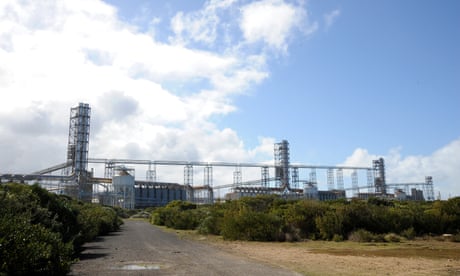
The bottom line is that the safeguard is a Coalition policy that has barely been used, but most experts think could be. Labor has strategically adopted its opponent’s model after repeat scare campaigns left it bruised and gun-shy on climate.
The Morrison government has built a hard-earned reputation as a global laggard on climate. It stuck with a low, seven-year-old 2030 emissions target despite significant international pressure, has no significant policies to cut emissions in that timeframe and claims a 20% emissions cut since 2005 despite most of that having come before it was elected in 2013.
It has a net zero emissions plan for 2050 that assumes the bulk of the work will come later, at odds with climate science advice, and does not actually add up to net zero. Despite the subsequent denials, LNP candidate and climate sceptic Colin Boyce was on to something this week when he said there is wriggle room in the net zero commitment.
Meanwhile, Morrison is suggesting using the Coalition’s policy to do what it was designed to would be economically disastrous. That should be treated as what it is: a scare campaign and an argument for inaction.
